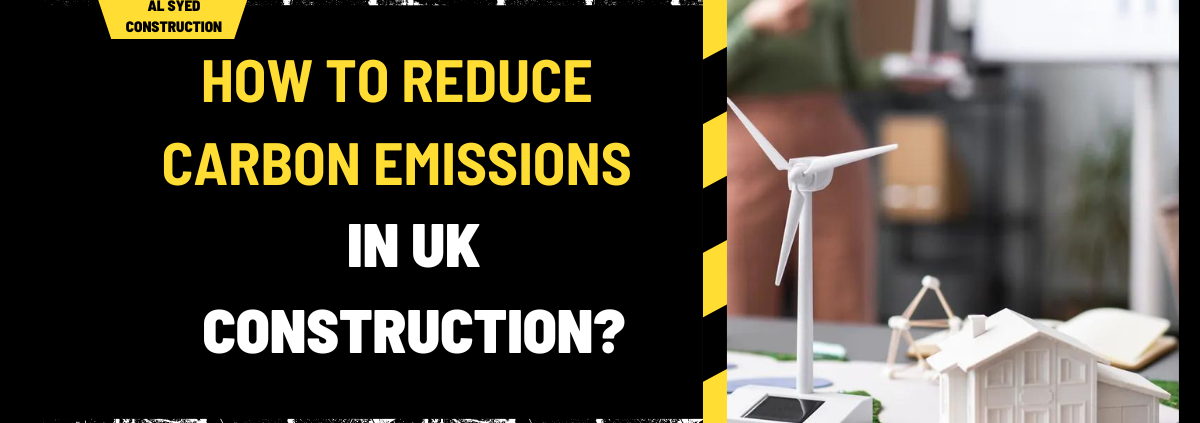How to Reduce Carbon Emissions in UK Construction: A Comprehensive Guide
Reducing carbon emissions in construction is crucial for mitigating climate change and promoting sustainable development. The construction industry, known for its significant carbon footprint, faces increasing pressure to adopt environmentally friendly practices. This guide explores effective strategies and practices for reducing carbon emissions throughout the construction lifecycle, from design to demolition.
Table of Contents
Understanding Carbon Emissions in Construction
Carbon emissions in construction primarily arise from the production, transportation, and installation of construction materials, as well as from construction machinery and processes. Addressing these emissions involves both reducing the carbon intensity of materials and improving operational efficiency.
1. Sustainable Design and Planning
Sustainable design is the foundation of reducing carbon emissions. Incorporating sustainability principles early in the design phase can lead to significant emissions reductions.
1.1. Energy-Efficient Building Design
Designing buildings with energy efficiency in mind helps reduce operational carbon emissions. Key strategies include:
- Passive Solar Design: Utilize natural sunlight for heating and cooling, reducing reliance on artificial systems.
- High-Performance Insulation: Implement advanced insulation materials to minimize heat loss and improve energy efficiency.
- Energy-Efficient Windows and Doors: Install windows and doors with high thermal performance to reduce energy consumption.
1.2. Incorporating Renewable Energy
Integrating renewable energy sources into building design can substantially reduce carbon emissions. Options include:
- Solar Panels: Install photovoltaic panels to generate clean electricity on-site.
- Wind Turbines: Use wind energy to complement other renewable sources.
- Geothermal Systems: Utilize the earth’s natural heat for heating and cooling.
2. Choosing Low-Carbon Materials
The selection of materials plays a crucial role in reducing carbon emissions. Opting for low-carbon and sustainable materials can significantly impact the overall carbon footprint of a construction project.
2.1. Recycled and Reclaimed Materials
Using recycled and reclaimed materials reduces the need for new resources and lowers carbon emissions associated with material production. Consider:
- Recycled Steel and Aluminum: Use metals that have been recycled from previous projects.
- Reclaimed Wood: Source wood from demolished structures or sustainable forestry practices.
2.2. Low-Carbon Concrete Alternatives
Concrete production is a major source of carbon emissions. Alternatives to traditional concrete include:
- Fly Ash Concrete: Incorporate fly ash, a byproduct of coal combustion, to reduce the amount of Portland cement needed.
- Geopolymer Concrete: Utilize industrial byproducts and natural materials to create low-carbon concrete alternatives.
2.3. Sustainable Building Products
Select building products with lower carbon footprints, such as:
- Bamboo: A rapidly renewable material with lower carbon emissions compared to traditional wood.
- Hempcrete: A combination of hemp fibers and lime, offering excellent thermal performance with a lower environmental impact.
3. Optimizing Construction Processes
Improving the efficiency of construction processes can lead to significant reductions in carbon emissions. Key areas to focus on include:
3.1. Efficient Use of Machinery
Construction machinery is a major source of emissions. To optimize its use:
- Modernize Equipment: Invest in newer, more efficient machinery that meets the latest emissions standards.
- Regular Maintenance: Ensure regular maintenance to keep equipment running efficiently and reduce emissions.
3.2. Reducing Waste
Minimizing waste on construction sites reduces the carbon footprint associated with material production and disposal. Implement waste reduction practices such as:
- Waste Segregation: Separate recyclable and non-recyclable waste to facilitate recycling and reduce landfill contributions.
- On-Site Recycling: Set up systems to recycle materials like concrete and wood on-site.
3.3. Green Construction Techniques
Adopt green construction techniques to reduce emissions:
- Modular Construction: Prefabricate building components off-site to reduce on-site construction time and associated emissions.
- Just-in-Time Delivery: Coordinate material deliveries to minimize storage and transportation emissions.
4. Improving Building Operation and Maintenance
Reducing carbon emissions doesn’t stop at construction completion. Ongoing operation and maintenance are critical to achieving long-term sustainability.
4.1. Energy Management Systems
Implement energy management systems to monitor and control energy usage:
- Building Management Systems (BMS): Utilize BMS to optimize heating, cooling, and lighting systems.
- Smart Thermostats: Install smart thermostats to improve energy efficiency and reduce heating and cooling costs.
4.2. Sustainable Building Certifications
Achieve certifications that demonstrate commitment to sustainability:
- LEED Certification: Obtain LEED (Leadership in Energy and Environmental Design) certification for buildings that meet high standards of environmental performance.
- BREEAM Certification: Pursue BREEAM (Building Research Establishment Environmental Assessment Method) certification for sustainable building practices.
5. Educating and Training Workforce
Educating and training the workforce is essential for implementing sustainable practices effectively.
5.1. Training Programs
Develop training programs for construction professionals to enhance their knowledge of sustainable practices:
- Sustainable Construction Workshops: Offer workshops on sustainable building materials and techniques.
- Certifications and Courses: Provide access to certifications and courses on green building practices.
5.2. Promoting Awareness
Raise awareness about the importance of reducing carbon emissions:
- Industry Conferences: Participate in industry conferences and seminars focused on sustainability.
- Publications and Resources: Distribute publications and online resources on best practices for reducing emissions.
Conclusion
Reducing carbon emissions in construction is a multifaceted challenge that requires a comprehensive approach. By focusing on sustainable design, selecting low-carbon materials, optimizing construction processes, improving building operations, and educating the workforce, we can make significant strides toward a more sustainable future. Implementing these strategies not only helps mitigate climate change but also enhances the overall quality and performance of construction projects.




